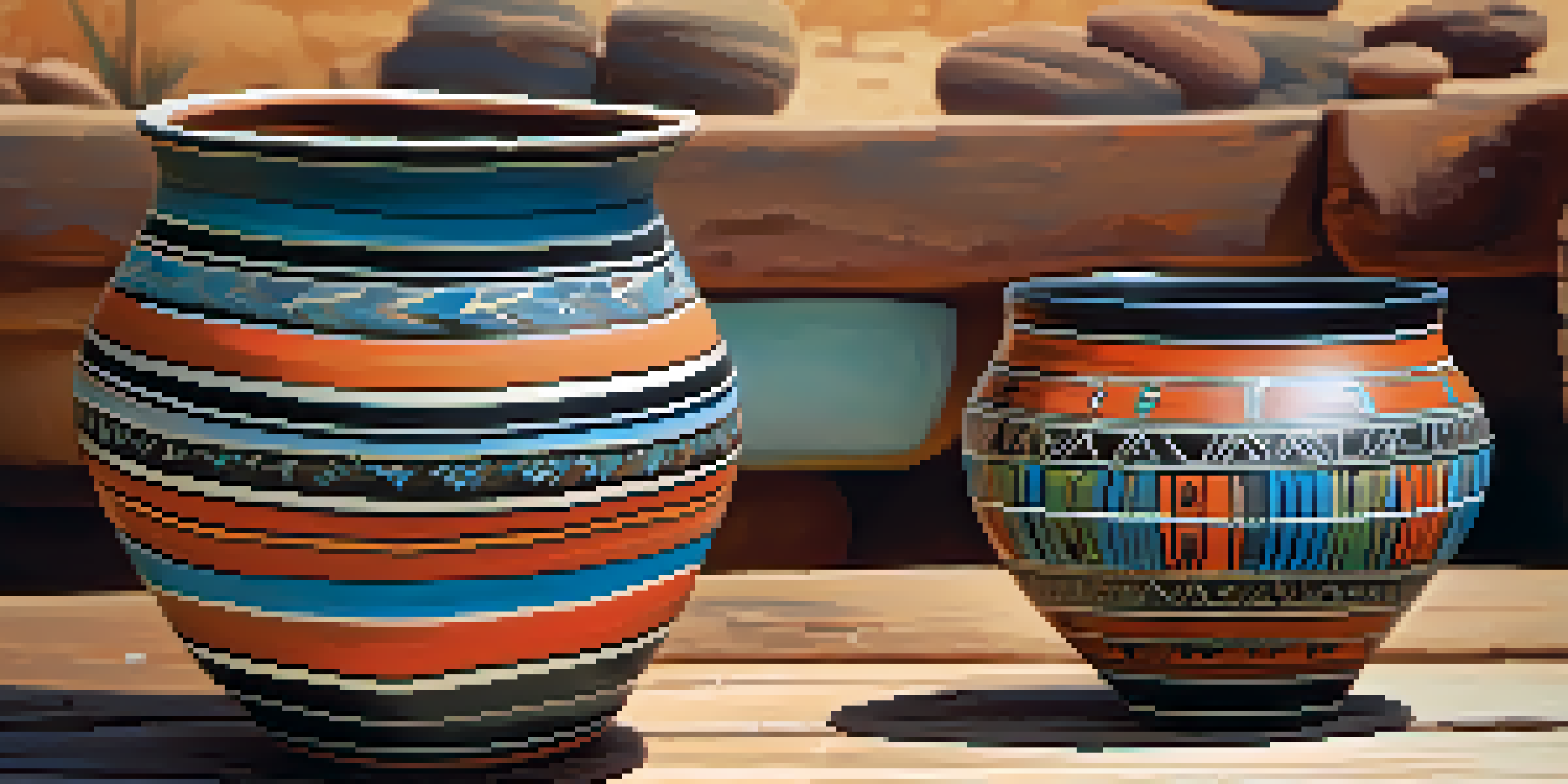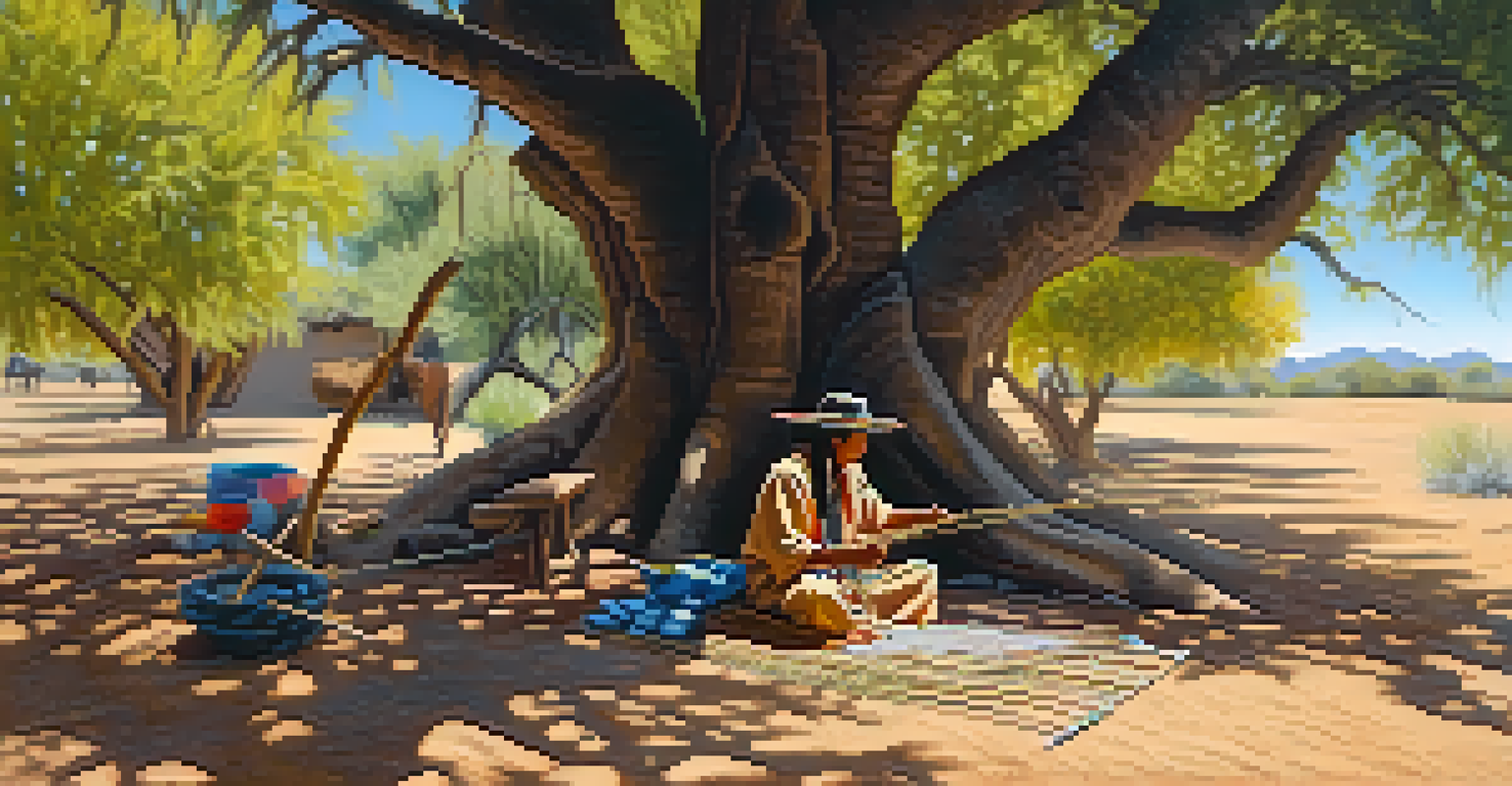Cultural Impact of Native American Artifacts in Arizona

Understanding Native American Artifacts in Arizona
Native American artifacts are tangible pieces of history that offer profound insights into the cultures that once thrived in Arizona. These items, which range from pottery and textiles to tools and jewelry, represent not just craftsmanship but also the values, beliefs, and everyday lives of Indigenous peoples. By studying these artifacts, we can gain a deeper understanding of the intricate relationships between Native Americans and their environments.
The past is never dead. It's not even past.
For instance, traditional pottery not only served functional purposes but also conveyed stories and spiritual beliefs through intricate designs. Each piece can tell us about the community it originated from, reflecting social structures, trade practices, and even the ecological knowledge of the people. This connection to the land and culture is vital for recognizing the legacy that these artifacts carry.
Moreover, the preservation and display of these artifacts in museums and cultural centers provide opportunities for education and engagement. They invite visitors, both local and global, to appreciate the rich cultural tapestry of Native American communities in Arizona, fostering respect and understanding across diverse audiences.
The Role of Artifacts in Cultural Identity
Artifacts play a pivotal role in shaping and maintaining cultural identity among Native American communities. They serve as reminders of ancestral heritage, connecting contemporary Indigenous peoples to their forebears. This continuity not only strengthens community bonds but also instills a sense of pride in their history and traditions.

For example, the revival of traditional weaving techniques among tribes like the Navajo showcases how these artifacts can inspire modern artistic expressions while honoring historical practices. As younger generations learn these skills, they not only keep traditions alive but also adapt them to current contexts, thereby enriching their cultural identity.
Artifacts Reflect Cultural Identity
Native American artifacts are vital for preserving cultural heritage and connecting contemporary Indigenous peoples to their ancestral roots.
Additionally, these artifacts often become symbols of resistance and resilience. In the face of historical challenges, preserving and celebrating their cultural artifacts allows Native American communities to assert their identity and counteract narratives that have marginalized their histories.
Artifacts as Educational Tools
Native American artifacts serve as powerful educational tools that can bridge gaps between cultures. Schools, museums, and cultural institutions often use these objects to teach about Indigenous histories, arts, and philosophies. This educational approach fosters a greater appreciation for the depth of Native American experiences and encourages respectful dialogue.
Artifacts are not merely objects; they are the voices of our ancestors, whispering their stories to us.
For instance, interactive exhibits that include replicas of artifacts or hands-on workshops allow participants to engage with history in a more meaningful way. Such experiences help dismantle stereotypes and promote a more nuanced understanding of Native American cultures. Visitors often leave with newfound respect and a desire to learn more.
Moreover, incorporating Indigenous perspectives into educational curricula can empower Native American voices. By prioritizing their histories and narratives, these programs help correct historical inaccuracies and promote inclusivity, ensuring that future generations recognize the significance of these artifacts.
The Impact of Tourism on Artifact Preservation
Tourism has a significant impact on the preservation of Native American artifacts in Arizona. While it can provide necessary funding and awareness for conservation efforts, it also presents challenges, such as the potential for exploitation or misrepresentation of Indigenous cultures. Balancing these dynamics is crucial for protecting these sacred items and the stories they tell.
Community-led tourism initiatives often focus on ethical practices that respect Indigenous rights and knowledge. By involving Native American communities in tourism development, these initiatives ensure that the narratives shared are authentic and empowering. This approach not only supports local economies but also allows visitors to engage with the culture on a deeper level.
Education Through Artifacts
Artifacts serve as powerful educational tools, promoting understanding of Indigenous histories and cultures in schools and museums.
However, it is essential for tourists to be mindful of their role in this ecosystem. Understanding the historical context and cultural significance of artifacts fosters a sense of responsibility and respect. By promoting ethical tourism, we can contribute to the preservation of Native American artifacts for future generations.
Contemporary Art and Its Roots in Tradition
Contemporary Native American art is deeply intertwined with traditional practices, often drawing inspiration from historical artifacts. Artists today frequently incorporate techniques, symbols, and materials that have been passed down through generations, creating a dialogue between past and present. This fusion of old and new not only honors their heritage but also resonates with modern audiences.
For instance, many Native artists utilize traditional storytelling methods in their work, conveying contemporary themes through culturally significant lenses. This approach allows them to address current social issues while celebrating their identities, creating a powerful platform for expression and advocacy. The resulting art serves as both a tribute to their ancestors and a reflection of their lived experiences today.
Moreover, the recognition and appreciation of contemporary Native American art in galleries and exhibitions help elevate these stories on a larger stage. By showcasing diverse voices and perspectives, these platforms challenge stereotypes and foster a greater understanding of the complexities of Indigenous cultures.
Legal and Ethical Considerations in Artifact Ownership
The ownership and repatriation of Native American artifacts raise complex legal and ethical questions. Many artifacts are housed in museums or private collections, often without the consent of the tribes they originated from. This disconnection from their cultural significance can lead to a sense of loss and frustration among Indigenous communities.
Legislation such as the Native American Graves Protection and Repatriation Act (NAGPRA) aims to address these issues by providing a framework for the return of culturally significant items to their rightful owners. However, the process can be slow and complicated, highlighting the need for ongoing dialogue between institutions and tribal communities.
Tourism's Dual Impact on Preservation
While tourism can aid in the conservation of Native American artifacts, it also poses challenges that require ethical engagement from visitors.
Engaging in conversations about the rightful ownership of artifacts can foster healing and understanding. By recognizing the importance of these items to Indigenous identities and cultures, we can work towards solutions that honor their histories and support their continued cultural expression.
The Future of Native American Artifacts in Arizona
Looking ahead, the future of Native American artifacts in Arizona hinges on collaborative efforts between tribes, museums, and educational institutions. By prioritizing Indigenous voices in discussions about preservation and representation, we can ensure that these artifacts continue to be celebrated and protected. This collaboration can also foster innovative approaches that blend traditional knowledge with contemporary practices.
As awareness of cultural heritage grows, there is a collective responsibility to advocate for the rights and recognition of Native American communities. Supporting initiatives that promote ethical tourism and education can contribute to a more respectful understanding of these artifacts and their significance. The more we learn, the better equipped we are to honor their legacies.

Ultimately, the cultural impact of Native American artifacts in Arizona is an evolving narrative. By engaging with these stories and fostering respectful relationships, we can contribute to a future where these artifacts are cherished not just as relics of the past but as vibrant components of living cultures.